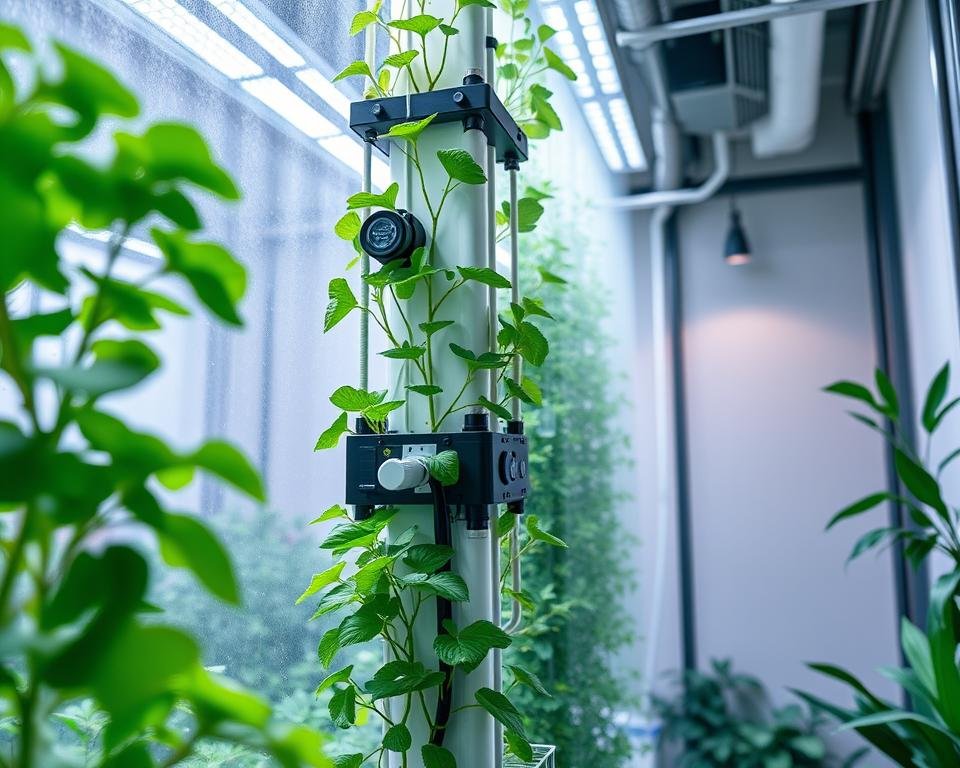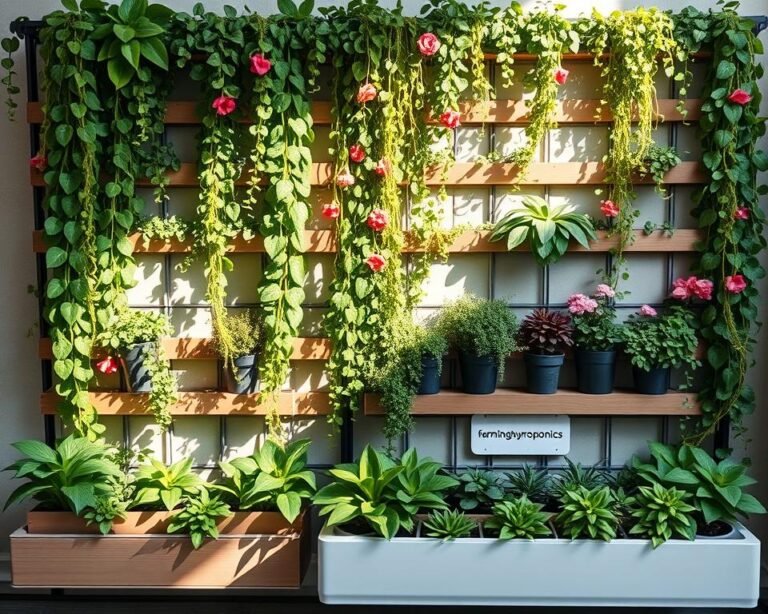Aeroponic Tower: The Revolutionary Vertical Gardening Solution
Imagine turning a small urban area into a lush garden that grows fresh, healthy food all year. This isn’t just a dream—it’s real with aeroponic tower gardening. These smart vertical-farming systems change how we grow food, perfect for those with little space but a love for fresh veggies.
An aeroponic-tower is a new way to garden indoors, moving away from old soil-based methods. It suspends roots in air and sprays nutrients, letting you grow more food in less space. It’s great for city folks with small balconies or home gardeners looking for a modern method.
The tech behind these systems is truly groundbreaking. Plants grow 40% faster than usual, and use 90% less water. It’s not just gardening—it’s a smart, green way to grow your own food.
Key Takeaways
- Aeroponic towers enable rapid plant growth in minimal space
- Innovative vertical-farming technology reduces water consumption
- Suitable for urban environments with limited gardening areas
- Provides year-round fresh produce cultivation
- Dramatically increases growing efficiency compared to traditional methods
Understanding Aeroponic Tower Systems
Aeroponic tower systems are changing urban-farming. They let us grow plants in small spaces. These systems are making farming more productive and using less resources.
Core Components and Design Features
A typical aeroponic tower system has several parts:
- Vertical growing tower
- Nutrient reservoir
- Water pump
- Misting nozzles
- Growing chambers
The Science Behind Aeroponics
Aeroponic systems create a special growing space. Plant roots hang in the air and get misted with nutrient-rich water. This method has big advantages:
- Uses up to 95% less water than traditional farming
- Promotes faster plant growth
- Enables precise nutrient delivery
“Aeroponics transforms plant cultivation by eliminating soil and maximizing nutrient absorption” – Agricultural Innovation Research
Modern Applications in Urban Farming
Urban-farming has found a great ally in aeroponic-tower systems. These systems let city folks grow food in small spaces. They can grow up to 52 plants per tower, making a lot of food without needing a lot of land.
Aeroponic-tower systems use advanced tech and smart design. They’re not just for gardening. They’re a sustainable way to grow food for the future.
How Nutrient Delivery Works in Vertical Systems

Vertical-farming is a new way to grow food without soil. It changes how we farm by using hydroponic-systems. These systems make sure plants get the right nutrients in a very efficient way.
The heart of nutrient delivery in vertical farms is a complex process. It changes how plants get the minerals and water they need:
- Nutrient solution stored in a special reservoir
- High-precision pumps move the solution
- Special nozzles make a fine nutrient mist
- Roots absorb the nutrients from the air
“The future of agriculture is suspended in a fine mist of potential” – Urban-Farming Innovator
Aeroponic systems save a lot of water, using up to 90% less than traditional farming. The way nutrients are delivered gives farmers great control. This control brings many benefits:
- Exact control over nutrient levels
- Very little water is wasted
- Plants absorb nutrients faster
- Less chance of nutrient problems
Understanding how nutrients are delivered is key to success in vertical farming. Smart systems now adjust nutrient levels in real-time. This ensures plants grow the best they can.
Using advanced hydroponic systems can change urban farming. It helps grow more food with less resources.
Benefits of Aeroponic Tower Gardening
Aeroponic tower gardening is a new way to farm that’s good for the planet. It helps farmers and city gardeners grow food in a smart way. These systems let us farm more densely without harming the environment.

Water Conservation and Efficiency
Aeroponic towers save a lot of water. Old farming ways use a lot of water, but aeroponic systems use up to 98% less. This is great for places with little water and big environmental problems.
- 99% less land usage compared to conventional farming
- 98% reduced water consumption
- 85% fewer food miles
- Sustainable agricultural practice
Space-Saving Advantages
Urban gardeners and small farmers love aeroponic towers. They use space well, turning small areas into places where lots of food can grow. This is perfect for city apartments, rooftops, and small spaces.
“Aeroponic towers turn small spaces into abundant food production centers.” – Urban Farming Innovators
Enhanced Growth Rates and Yields
Aeroponic towers make plants grow faster. Plants can grow up to three times faster than in soil. This is because they get the right food and don’t get sick from soil diseases.
| Growing Method | Growth Rate | Water Usage |
|---|---|---|
| Traditional Farming | Standard Growth | High Water Consumption |
| Aeroponic Towers | 3x Faster Growth | 98% Less Water |
Using aeroponic tower gardening means you’re part of a big change. It’s a way to farm that’s efficient, saves resources, and grows lots of food.
Setting Up Your First Aeroponic Tower
Starting your indoor-gardening with an aeroponic tower needs careful planning. It’s a smart way to grow plants in small spaces. Knowing how these towers work is key to growing plants well.

- Choose an optimal location with stable temperature and access to electrical outlets
- Ensure sufficient vertical clearance for tower height
- Gather necessary setup equipment
- Prepare your nutrient solution
“Success in aeroponic gardening starts with meticulous preparation and attention to detail.”
Your tower’s setup involves several critical components:
| Component | Recommended Specification |
|---|---|
| Lighting | 16 hours daily, LED grow lights preferred |
| pH Level | 5.5 – 6.5 range |
| Water Misting | 15-30 seconds intervals |
When picking plants, start with quick-growing varieties like lettuce or herbs. These grow fast and are good for beginners. Leafy greens like lettuce grow in 30-45 days, perfect for beginners.
Check your system every day to catch problems early. Look at water levels, nutrient levels, and system work. With the right setup and care, your aeroponic tower can grow amazing plants. It saves water and uses space well.
Essential Maintenance and Monitoring
Keeping your vertical farm in top shape is key. A well-cared-for aeroponic tower boosts plant health and yields. It makes your controlled environment agriculture thrive.
Effective management of your aeroponic tower is vital. It ensures your system works well:
pH and Nutrient Level Management
It’s important to watch your nutrient levels for plant growth. Here’s how to do it:
- Use a digital pH meter to check levels weekly
- Keep pH between 5.5 and 6.5 for best nutrient uptake
- Use electrical conductivity (EC) meters to measure nutrient levels
Cleaning and Sanitization Protocols
Keeping your tower clean stops diseases:
- Flush the system every 2-4 weeks
- Sanitize with food-grade hydrogen peroxide
- Look for algae or mineral buildup on grow sites
Troubleshooting Common Issues
Watch for problems to avoid system failures:
| Issue | Solution |
|---|---|
| Clogged Nozzles | Clean with vinegar solution, replace if damaged |
| Pump Malfunction | Check electrical connections, test pump performance |
| Root Health | Inspect roots weekly, trim if discoloration occurs |
“Regular maintenance is the secret to a thriving aeroponic garden.” – Vertical Farming Expert
Follow these maintenance tips to get the most from your aeroponic tower. You’ll see consistent growth and high yields in your urban farm.
Best Plants for Aeroponic Tower Growing
Choosing the right plants for your aeroponic tower can change your indoor-gardening. The best aeroponic-towers for home gardening are great for growing many plants efficiently and sustainably.
Leafy greens are top picks for aeroponic systems. They do well in vertical spaces, giving great results with little space and resources.
- Lettuce varieties: Grow up to 8 times more yield per square foot
- Spinach: Rapid growth cycles with continuous harvesting potential
- Kale: Nutrient-dense and perfectly suited for vertical cultivation
Herbs are another great choice for indoor-gardening. Their shallow roots are perfect for aeroponic towers, offering big benefits:
- Quick seed-to-harvest turnaround
- Minimized risk of root rot
- Continuous fresh herb production
Compact fruiting plants like strawberries also do well in aeroponic systems. These berries grow fast, cutting down on traditional growing times.
“Aeroponics transforms urban spaces into productive gardens, making fresh produce accessible to everyone.” – Urban Farming Expert
| Plant Type | Growth Cycle | Water Efficiency |
|---|---|---|
| Leafy Greens | 3-4 weeks | 90% less water usage |
| Herbs | 4-6 weeks | 85% water conservation |
| Strawberries | 8-10 weeks | 95% reduced water consumption |
Your aeroponic tower can be a source of fresh, sustainable produce. This is true with the right plant choices and care.
Conclusion: Embracing the Future of Urban Agriculture
Aeroponic towers are changing urban farming. They use vertical farming to save up to 90% of water. Urban agriculture is now a real part of our food systems.
Joining the green revolution can make a big difference. You can grow fresh, pesticide-free food in small spaces. This cuts down on food miles and carbon emissions.
Companies like AeroFarms show what’s possible. They grow many crops with little environmental impact. This creates jobs, improves food security, and strengthens communities.
As cities grow, we need sustainable farming more than ever. Aeroponic towers offer a solution that fits well in cities. They help everyone, from gardeners to city planners, make food systems better.
The future of urban farming looks good. New tech makes vertical farming easier and more effective. By using these innovations, you can help make food systems more sustainable and beneficial for everyone.







